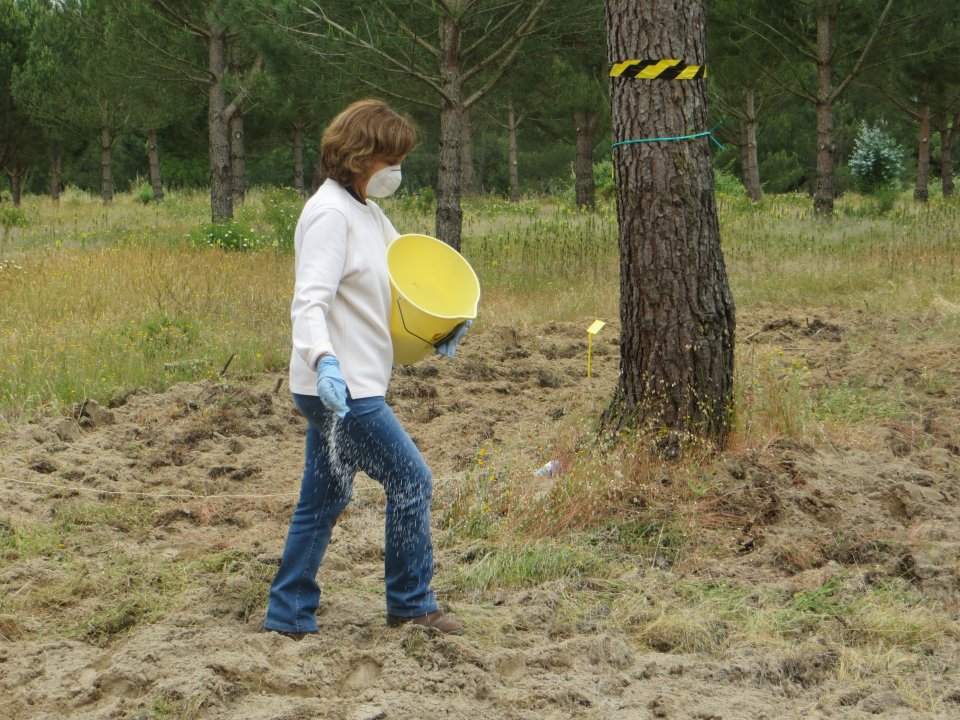
Rational fertilization can improve tree health, growth and potentially benefit pine cone and pine nut production. The reduction of forest exploitation costs without neglecting environmental factors and promoting biodiversity is an important management achievement in the context of climate change.
To establish fertilizer recommendations in stone pine for cone production, it is crucial to evaluate soil fertility, tree nutritional status and, if irrigated, the quality of the irrigation water. Here we present part of the results of the operational group FERTIPINEA, focused on the analysis of Portuguese stone pine stands regarding soil physical and chemical characteristics.
In a context of intensive exploitation of stone pine in Portugal for cone and pine nut production, the use of novel forest management techniques, including irrigation and fertilization, is increasing. At present the fertilizer recommendations are based on empirical knowledge, highlighting the need to develop experimental work. When planting new stands, soil analysis should be used to assess fertility status. In already installed young and adult stands, soil and foliar analysis must be performed, similarly to what is done in an agricultural context.
In 34 permanent plots of stone pine in the Portugal, soil samples were collected at 0-0.2 m and 0.2-0.5 m depths. The analytical results show that most soils had coarse texture (sand, loamy sand and sandy loam), with a slightly or moderately acid reaction [pH(H2O) 4.6 to 6.5], low content of soil organic matter at the surface (0.6-1.5%) and very low at the sub superficial layer (≤0.5%).
Levels are mostly very low for extractable phosphorus (<25 mg kg-1 P2O5), moderate for extractable potassium (51 to 100 mg kg-1 K2O), low for extractable magnesium (31 to 60 mg kg-1 Mg), very low for extractable boron (≤0.2 mg kg-1 B). Are also very low for potential cation exchange capacity (≤5.0 cmol(+) kg-1) and low to moderate for base saturation (21-60%).
Results from the soil analysis reveal that portuguese stone pine stands grows mainly on sands with acid reaction, low levels of organic matter, extractable phosphorus, boron and other nutrients, and low potential cation exchange capacity. These soils, caracterized by a generally low fertility, a rational fertilization may help to improve species resistance to biotic and abiotic stresses, and potentially help to achieve a higher and more regular cone production.
Is therefore necessary to use soil analysis as one of the diagnostic tools for establishing rational fertilizer recommendations.
Stone pine producers, forestry technicians, forestry associations, central and local governmental technicians, and also certified laboratories and other institutions may benefit from the obtained knowledge. There is a rising interest in fertilizer application to increase pine nut production and reduce the inter-annual masting variability of cone production of the species. However, there is an interplay of environmental and management factors influencing cone production, meaning that it is fundamental to develop experimental work over an extended period, in stands with representative characteristics and installed in different soil and climatic conditions.
In the future, the ongoing experimental work under the FERTIPINEA project - Nutrition and fertilization of rainfed and irrigated Pinus pinea stands (PDR2020-101-031330) should continue to collect long term data series so that robust rational fertilizer recommendations may be established for rainfed and irrigated stone pine stands. These recommendations can be applied to young and mature stands or future plantations.
M. Encarnacao Marcelo, encarnacao.marcelo@iniav.pt, http://www.iniav.pt/
Alexandra Correia, alexandrac@isa.ulisboa.pt, http://www.isa.ulisboa.pt/en/cef
Conceicao Santos Silva, mcssilva@unac.pt, http://www.unac.pt/
Further information
http://www.unac.pt/index.php/id-i/grupos-operacionais-accao-1-1-pdr2020/fertipinea
Marcelo, M. E., Carrasquinho, I., Jordão, P., Mano, R., Calouro, F., Gaspar, M., Gomes, J. P. A., Melo, I., Martins, S., Silva, C. S., Amaral, M. R., Borges, C., Correia, A. P. (2020). Características físicas e químicas de solos ocupados com pinheiro-manso. Revista Vida Rural. Pag 24-27, Fevereiro 2020.
Credits: M. Encarnacao Marcelo
Credits: M. Encarnacao Marcelo
